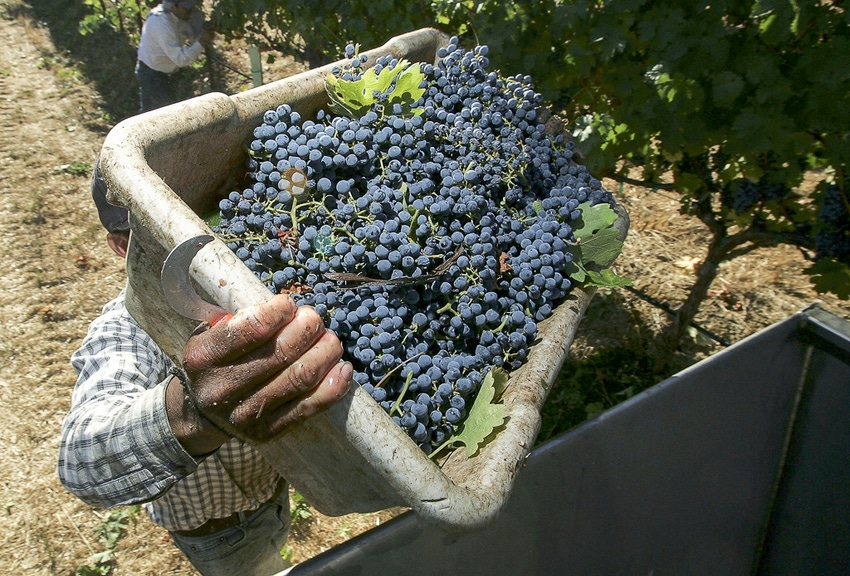
Possible eradication is still more than a year away, but impressive progress is underway in Napa County to eliminate the European grapevine moth (EGVM) from the landscape.
Napa County Agricultural Commissioner Greg Clark says the moth has not been seen or observed in traps since early 2014. He tells grape growers in the region if this continues through the 2016 harvest the California Department of Food and Agriculture can make a formal recommendation to the U.S. Department of Agriculture to declare eradication.
Formal eradication cannot be declared until the county has zero detections of the EGVM for six generations.
“I’ve been telling growers that it’ll be sometime after the 2016 harvest,” he said.
The EGVM is a yield-robbing pest affecting grapes that has, in extreme cases, destroyed entire grape crops.
According to the University of California (UC), Lobesia botrana (EGVM) was first reported in the United States in Napa County in Oct. 2009. Native to Southern Italy, it was first described from Austria and is now found throughout Europe, North and West Africa, the Middle East, and eastern Russia.
It was more recently introduced into Japan, and in 2008 was reported in Chile.
In May and June, first-generation larvae web and feed on the flower clusters. Second-generation larvae (July-August) feed on green berries. Young larvae penetrate the berry and hollow them out, leaving the skin and seeds.
Third-generation larvae (August-Sept.) cause the greatest damage by webbing and feeding inside berries and within bunches, which become contaminated with frass (excrement).
Additionally, feeding damage to berries after veraison exposes them to infection by Botrytis and other secondary fungi such as Aspergillus, Alternaria, Rhizopus, Cladosporium, and Penicillium. Secondary pests such as raisin moth (Cadra figulilella), fruit flies, and ants may also be attracted to damaged berries, UC reports.
Within a year of discovering the pest in Napa County, officials had trapped over 100,000 EGVM.
How the moth arrived in Napa County, home to some of California’s premiere wines, is still a mystery.
“One of our concerns is we don’t know how it got here,” Clark said. Knowing how it got there could be important to preventing further introductions to this and other invasive pests.
As fast as the EGVM appeared and reproduced it seems to have dwindled in numbers in equal fashion. In 2011 officials trapped 113 EGVM. That number fell to 77 in 2012 and 40 in 2013.
There have been no finds since Jan. 1, 2014.
Team effort
Clark is quick to credit a team effort of county, state and federal officials for the EGVM reduction. He also points to a cooperative effort of the region’s grape growers and University of California Cooperative Extension farm advisors.
“We were fortunate to find early control methods, both organic and conventional, that worked,” he said.
Chemical tools to control the pest were relatively simple and effective, according to Clark. Those products were fortunately soft on beneficial insects.
Once eradication is formally declared, Clark's office will work with state and federal regulators on detection surveys to continue monitoring for the pest. He says those discussions are ongoing and protocols should be completed when the eradication declaration is made.
For the latest on western agriculture, please check out Western Farm Press Daily and receive the latest news right to your inbox.
Clark’s office is also working on projects and programs aimed at sampling for other pests that may not be in the area at this time, but could present a problem if they are discovered. He says it’s not wise to assume pests are not there or cannot arrive as “the world is becoming smaller and the ability for pests to travel long distances is becoming easier.”
An extensive media and public information campaign was used to inform growers and residents of EGVM dangers and the need to cooperate with officials in combating the pest.
Clark said growers were cooperative once they understood because they knew it was their livelihoods on the line as the EGVM can quickly make mush of grape clusters and render it unmarketable.
The cost to do all this wasn’t cheap. Clark said Napa County spent about $50 million with another $50 million from state and federal channels. That does not include the costs borne by wine grape growers in the region including control measures and lost yield.
Since mating disruption efforts compete with trapping, Clark says mating disruption efforts have ceased. Now Napa County Ag Department inspectors are making spot checks of coordinated spray efforts to keep the pest out of Napa County.
A quarantine remains for Napa and a sliver of neighboring Sonoma County, though no EGVM has been detected in Sonoma County. It is simply because of the proximity of an EGVM find to the border with Sonoma County that the quarantine boundary extends there, Clark said.
A map of the quarantine area is available.
The EGVM was previously discovered in 10 other California counties, but was eliminated through control efforts, Clark says.
About the Author(s)
You May Also Like






